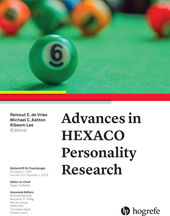On the Curious History of the Big Six
Variable Selection and “Moral Exclusion” in the Formation of Fundamental Personality Models
Abstract
Abstract. The Big Five became the foremost model of personality-trait structure in the last three decades, but was formed out of item/variable selections that partially or totally omitted dispositional content related to morality, ethics, integrity, and honesty. Such morality-relevant content has, for several reasons reviewed, extreme importance within the dimension of dispositional tendencies. Previous histories of the Big Five ignore details that account for this pattern of moral-content exclusion, exclusion that tended to impede identification of a key factor in a Big Six or HEXACO model. Here, a set of frequently referenced and highly morality-relevant adjective concepts are identified, based on ratings by 10 judges. The treatment of these concepts enables a tracing of the specific routes and rationales by which exclusion (and partial inclusion) operated in key lexical studies of the archaic period of lexical studies (up through 1993; in English and German), that reveals how variable-selection decisions by early investigators tended to impede identification of an important dimension of personality. Recommendations are offered for future personality-structure research.
References
(1936). Trait-names: A psycho-lexical study. Psychological Monographs, 47(1).
(1990a). German taxonomy of personality-descriptive terms: List of 5,160 adjectives. Round II: November 1, 1990. Unpublished report.
(1990b). Toward a taxonomy of personality descriptors in German: A psycho-lexical study. European Journal of Personality, 4, 89–118. https://doi.org/10.1002/per.2410040204
(2004). A hierarchical analysis of 1, 710 English personality-descriptive adjectives. Journal of Personality and Social Psychology, 87, 707–721. https://doi.org/10.1037/0022-3514.87.5.707
(2004). A six-factor structure of personality-descriptive adjectives: Solutions from psycholexical studies in seven languages. Journal of Personality and Social Psychology, 86, 356–366. https://doi.org/10.1037/0022-3514.86.2.356
(1936). Language, truth, and logic. London, UK: Gollancz.
(2005). The cultural animal: Human nature, meaning, and social life. New York, NY: Oxford University Press.
(1999). Hierarchy in the forest: The evolution of egalitarian behavior. Cambridge, MA: Harvard University Press.
(2012). Moral origins: The evolution of virtue, altruism, and shame. New York, NY: Basic Books.
(1943). The description of personality: Basic traits resolved into clusters. Journal of Abnormal and Social Psychology, 38, 476–506. https://doi.org/10.1037/h0054116
(1992). NEO Personality Inventory–Revised (NEO-PI-R) and NEO Five-Factor Inventory (NEO-FFI) professional manual. Odessa, FL: Psychological Assessment Resources.
(2009). Reputation: A network interpretation. New York, NY: Oxford University Press.
(1996).
The curious history of the five-factor model . In J. S. WigginsEd., The five-factor model of personality: Theoretical perspectives (pp. 1–20). New York, NY: Guilford Press.(1957). The social-desirability variable in personality assessment and research. New York, NY: Dryden.
(1990). An alternative “description of personality”: The Big-Five factor structure. Journal of Personality and Social Psychology, 59, 1216–1229. https://doi.org/10.1037/0022-3514.59.6.1216
(1992). The development of markers for the Big-Five factor structure. Psychological Assessment, 4, 26–42. https://doi.org/10.1037/1040-3590.4.1.26
(1987). Category-breadth and social-desirability values for 573 personality terms. European Journal of Personality, 1, 241–258. https://doi.org/10.1002/per.2410010405
(2008).
A cultural species . In M. BrownEd., Explaining culture scientifically (pp. 184–210). Seattle, WA: University of Washington Press.(2009).
Animal “culture”? . In K.N. LalandB.G. GalefEds., The question of animal culture. Cambridge, MA: Harvard University Press.(1996). In J. S. WigginsEd.,
A socioanalytic perspective on the five-factor model . The five-factor model of personality: Theoretical perspectives (pp. 163–179). New York, NY: Guilford Press.(2008). The HEXACO personality factors in the indigenous lexicons of English and 11 other languages. Journal of Personality, 76, 1001–1053. https://doi.org/10.1111/j.1467-6494.2008.00512.x
(2012). The H factor of personality: Why some people are manipulative, self-entitled, materialistic, and exploitive – and why it matters for everyone. Waterloo, ON: Wilfred Laurier University Press.
(1932).
The foundations of personality . In P. S. AchillesEd., Psychology at work (pp. 81–101). New York, NY: McGraw-Hill.(2007).
Cultural psychology of moral development . In S. KitayamaD. CohenEds., Handbook of cultural psychology (pp. 477–499). New York, NY: Guilford Press.(1967). 2800 personality trait descriptors: Normative operating characteristics for a university population. Ann Arbor, MI: Department of Psychology, University of Michigan.
(1955). Factor analysis of meaning. Journal of Experimental Psychology, 50, 325–338. https://doi.org/10.1037/h0043965
(1990). Sprache und Persönlichkeitsstruktur: Zur Validität des Fünf-Faktoren-Modells der Persönlichkeit
[Language and personality structure: On the validity of the five-factor model of personality] . Regensburg, Germany: S. Roderer Verlag.. (1990). Oxford, UK: Clarendon.
(1997). Effects of variable selection on the factor structure of person descriptors. Journal of Personality and Social Psychology, 73, 1296–1312. https://doi.org/10.1037/0022-3514.73.6.1296
(2003). Factor structure of English-language personality type-nouns. Journal of Personality and Social Psychology, 85, 695–708. https://doi.org/10.1037/0022-3514.85.4.695
(2009). Recurrent personality dimensions in inclusive lexcal studies: Indications for a Big Six structure. Journal of Personality, 77, 1577–1614. https://doi.org/10.1111/j.1467-6494.2009.00593.x
(2001). Lexical studies of indigenous personality factors: Premises, products, and prospects. Journal of Personality, 69, 847–879. https://doi.org/10.1111/1467-6494.696167
(2014). Human attribute concepts: Relative ubiquity across twelve mutually isolated languages. Journal of Personality and Social Psychology, 107, 199–216. https://doi.org/10.1037/a0036492
(2014). A basic bivariate structure of personality attributes evident across nine widely diverse languages. Journal of Personality, 82, 1–14. https://doi.org/10.1111/jopy.12028
(2001). Values hierarchies across cultures: Taking a similarities perspective. Journal of Cross-Cultural Psychology, 23, 268–290. https://doi.org/10.1177/0022022101032003002
(1944). Ethics and language. New Haven, CT: Yale University Press.
(2014). The essential moral self. Cognition, 131, 159–174. https://doi.org/10.1016/j.cognition.2013.12.005
(1961/1992). Recurrent personality factors based on trait ratings (Technical Report No. ASD-TR-61-97). Lackland Air Force Base, TX: US Air Force. (Reprinted in Journal of Personality, 60, 225-251). https://doi.org/10.1111/j.1467-6494.1992.tb00973.x
(1933). The American v. the German methods of approach to the study of temperament and personality. British Journal of Psychology, 24, 156–177.
(1970).
Introduction . In G. WallaceA. D. M. WalkerEds., The definition of morality. London, UK: Methuen.. (1928). Springfield, MA: Merriam Webster.
(2004). Moral animals: Ideals and constraints in moral theory. Oxford, UK: Oxford University Press.



